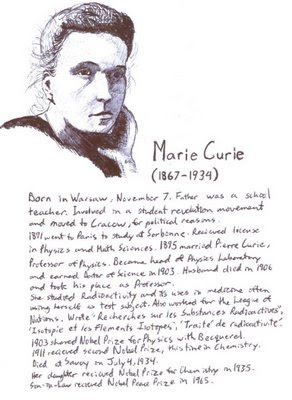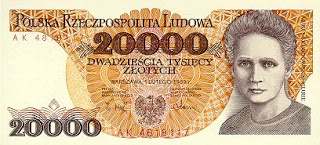In honor of one of the great pioneers in radiation history, Madame Curie, I thought it would only be fitting to share an overview of her contribution to the world and the future of cancer care.
A Brilliant MindMarie Curie was born in Warsaw, Nov.7 1867. In 1891 she went to Paris to study at Sorbonne and received her Physics degree. She married Pierre Curie, a professor of physics, in 1895. In1898 Pierre and Marie named the elements "Polonium,” and named "Radium" for its intense radioactivity — a word that they coined. She shared the Nobel Prize for Physics with Becquerel (another pioneer in the field of radiation),in 1903 and was the first woman to be awarded a Nobel Prize. In 1906 her husband died and she took over as physics professor, the first female professor at the University of Paris. She studied Radioactivity and its uses in medicine, often using herself as a test subject. Her first studies were conducted into the treatment of neoplasms (cancers), using radioactive isotopes. In 1911 she received a second Nobel Prize, this time in chemistry, and was the first person honored with Nobel Prizes in two different sciences. Since she was unaware of the deleterious effects of radiation exposure, she would work with radioactive substances with no protection; Marie and Pierre had no idea what price they were paying for their research.The damaging effects of ionizing radiation were then not yet known, and much of her work had been carried out in a shed without any safety measures. Curie had carried test tubes containing radioactive isotopes in her pocket and stored them in her desk drawer, remarking on the pretty blue-green light that the substances would give off in the dark. Due to their levels of radioactivity, her papers from then (and even her cookbook) are considered too dangerous to handle. They are kept in lead-lined boxes; those who wish to consult them must wear protective clothing. |
Marie Curie died in Passay, France on July 4th, 1934 at the age of 66, from aplastic anemia, almost certainly contracted from exposure to high levels of radiation.
Thanks to her research we now target cancer cells and destroy them with radiation, most all cancers can be cured with high enough doses of radiation. Research continues in trying to target tumors more specifically, allowing radiation to be more effective against cancer, and in turn decreasing or eliminating side effects.
The Curie (symbol Ci), a unit of radioactivity, is named in her and Pierre's honor as is the element with atomic number 96 -Curium. She even has a currency with her face on it.
Thanks to her research we now target cancer cells and destroy them with radiation, most all cancers can be cured with high enough doses of radiation. Research continues in trying to target tumors more specifically, allowing radiation to be more effective against cancer, and in turn decreasing or eliminating side effects.
The Curie (symbol Ci), a unit of radioactivity, is named in her and Pierre's honor as is the element with atomic number 96 -Curium. She even has a currency with her face on it.




